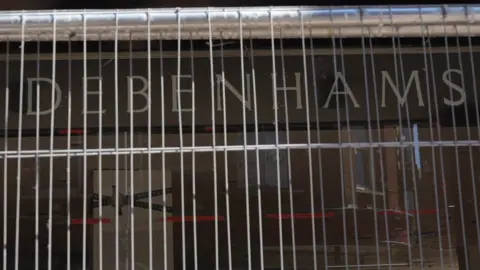The article titled “What has happened to the closed Debenhams stores?” presents a comprehensive overview of the fate of Debenhams’ physical shops after the iconic British retailer shut its doors for good on May 15, 2021. This closure marked the end of an era, where Debenhams had been a staple of the High Street for over 200 years. While the brand continues to thrive online, questions remain regarding the future of its numerous brick-and-mortar locations, which once sprawled across the UK.
Debenhams, a beloved department store chain, had maintained physical operations up until its ultimate collapse, grappling with increasing competition from online retailers, dwindling profits, and an upward trajectory of debt. The COVID-19 pandemic proved to be the final blow, leading to empty town centers across the UK. Despite this, some locations have undergone transformations, adopting new identities ranging from entertainment complexes to student housing.
In Northampton, a Debenhams location that once served as the site for Adnitt’s department store has seen plans for its demolition and conversion into student accommodations. Originally opened by the Adnitt Brothers in 1871, Debenhams took over the store in 1971 and later featured prominently in popular culture through a memorable scene in the BBC sitcom “Keeping Up Appearances.” After closing in early May 2021 due to the pandemic, the building’s transition into student housing reflects a growing trend of repurposing defunct retail spaces.
Moving east to Ipswich, the former Debenhams store on the bustling Cornhill remains vacant and poorly maintained, often referred to as a “blight” on the town center. Despite reported interest from “well-known retailers,” the building’s owner has turned down multiple offers while outlining a pedestrianisation plan that could enhance commercial prospects. As local shoppers express disappointment at the building’s derelict state, sentiment reflects a broader concern regarding the emptiness in Ipswich without the anchor that Debenhams once provided.
Another notable offshoot of Debenhams’ closures can be seen in Bury St Edmunds. Here, the store has successfully transformed into a bustling Primark outlet since its closure. The shift embodies the resurgence many high street locations are hoping to achieve following the pandemic-induced upheaval.
In Norwich, however, the former Debenhams is also mired in controversy. After its closure, various proposals to convert the building into student accommodations have emerged, with concerns raised over the potential disruption to the character of the city center—highlighting the balance between modern needs and historical preservation. As of early 2024, a decision on these proposals is still pending.
Kings Lynn’s Debenhams store similarly remains unchanged since its closure during the initial lockdown, with efforts ongoing to convert the site into flats and retail space. Although plans outlined in 2022 have yet to materialize, the site continues to symbolize the challenges faced by towns transitioning from traditional retail setups to alternative uses.
Some Debenhams locations have found innovative solutions, like in Milton Keynes, where the store has been rejuvenated into a lively entertainment venue. This space now boasts a multi-purpose set up including bowling alleys and arcades, serving a fresh purpose for the community while drawing in foot traffic.
Lastly, Colchester’s former Debenhams store illustrates the challenges of revitalizing spaces left by closed retailers. Initial plans for thrilling attractions such as go-karting and trampolining fell through, leaving the site vacant and exacerbating local retail woes. However, there remains an optimistic perspective from Colchester City Council regarding potential transformations in the area that strive to restore vibrancy to the city center.
In conclusion, the fate of former Debenhams locations serves as a microcosm of the broader retail landscape in the UK, highlighting the struggles and opportunities in the ongoing evolution of urban spaces left in the wake of changing consumer habits and economic pressures.



